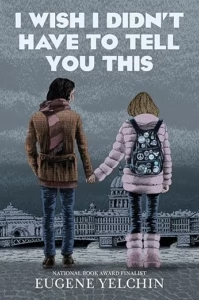I Wish I Didn’t Have to Tell You This
Eugene Yelchin
Candlewick Press
Published September 16, 2025
Amazon | Bookshop | Goodreads
About I Wish I Didn’t Have to Tell You This
In a stunning sequel to The Genius Under the Table, Eugene Yelchin’s graphic memoir depicts his harrowing journey from Leningrad’s underground art scene to a state-run Siberian asylum—and to eventual safety in the US.
No longer the creative little boy under his grandmother’s table, Yevgeny is now a young adult, pursuing his artistic dreams under the constant threat of the KGB’s stranglehold on Russia’s creative scene. When a chance encounter with an American woman opens him up to a world of romance and possibility, Yevgeny believes he has found his path to the future—and freedom overseas.
But the threat of being drafted into the military and sent to fight in Afghanistan changes everything in a terrible instant, and he takes drastic measures to decide his fate, leading to unthinkable consequences in a mental hospital.
With bold art bringing a vivid reality to life, National Book Award Finalist and Newbery Honoree Eugene Yelchin’s sequel to the acclaimed memoir The Genius Under the Table returns to Yevgeny’s saga, balancing the terror and oppression of Soviet Russia with the author’s signature charm and dark wit. I Wish I Didn’t Have to Tell You This shines a stark spotlight on history while offering a poignant, nuanced, and powerfully resonant look at growing up in—and ultimately leaving—Cold War Russia in the early 1980s.
My Review
I have not read The Genius Under the Table, so if there are references to that book in I Wish I Didn’t Have to Tell You This, then I missed them. Despite that, I followed the story just fine as I read this memoir. I don’t know that I realized it was a sequel as I was reading it.
The story can be grim, which won’t surprise anyone familiar with Russian history in the early 1980s. Yelchin does a wonderful job incorporating art, joy, and humor into the story, though. Yevgeny’s relationship with Libby is halting and sweet. I loved watching them figure out how to communicate with each other and the jokes they developed. For instance, they would ask each other if the other was “mixed up” about them, meaning did they have romantic feelings for one another.
It was easy to feel the tension Yevgeny felt as an artist. He knew he could be imprisoned, or worse, for making art. Late in the book, he is confined to a mental institution. At one point, a scene sort of fades to black, with Yevgeny in pretty dire straits. When the narrative resumes, we learn that he still carries the trauma of his experience, but has been freed.
Throughout the story, the narrative stays appropriate to the audience. The illustrations don’t show gratuitous violence, though the characters reference a murder that happens off-scene. The story also notes Russia’s invasion of Afganistan, and the high cost to human life the war creates.
At 432 pages, this graphic memoir is a little longer than other similar books, but it’s so worth reading. I loved the expressions on the characters’ faces. The illustrations are brilliant. Readers interested in European or Russian history will not want to miss this one.
Content Notes
Recommended for Ages 12 up.
Profanity/Crude Language Content
None.
Romance/Sexual Content
Kissing. Yevgeny’s grandmother inquires that he and his wife will not have privacy while they sleep if she moves in with the family.
Spiritual Content
None.
Violent Content
References to political assassination and bullying. References to antisemitism. At one point, Yevgeny is in a medical facility, and the scene sort of fades to black with a vague reference to torture and mistreatment.
Drug Content
Yevgeny goes to a party and possibly gets drunk? He falls down dancing and then walks home alone. It’s hard to tell if there was alcohol involved. If so, it’s not pictured. Characters smoke cigarettes in some scenes. Someone injects medication into a person’s arm without their consent.
Note: This post contains affiliate links, which do not cost you anything to use but help support this blog. I received a free copy of this book in exchange for my honest review. All opinions are my own.
